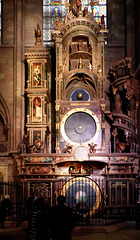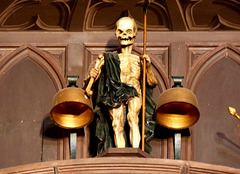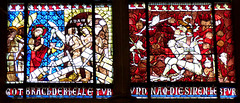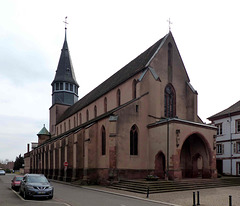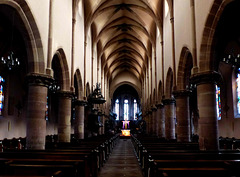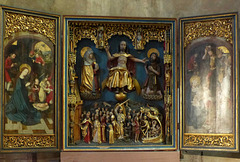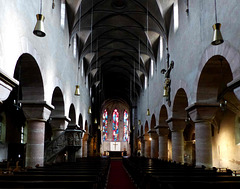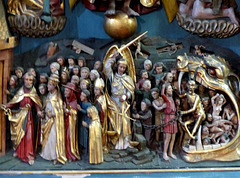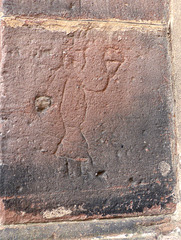
Alsace / Bas-Rhin
A collection of photos taken over the years. They just all have in common, that they were taken in the Bas-Rhin department of the Alsace / France. The Alsace, is now part of "Grand Est".
Strasbourg - Cathédrale Notre-Dame
| |
|
|
When Strasbourg was first mentioned in 12BC, it was the Roman camp Argentoratum. Strasbourg was probably a bishop's seat from the 4th century. Alemanni, Huns and Franks conquered the city in the 5th century. Strasbourg was then ruled by the Strasbourg bishops until 1262 when the citizens violently rebelled against the bishopric and Strasbourg became a free imperial city and so belonged to the Holy Roman Empire. Led by two rival patrician families (Müllheim and Zorn), the city prospered, although the town hall required two separate entrances for the two families.
On February 14, 1349, one of the first and largest pogroms of persecution of Jews in connection with the plague in the German area took place here. In the course of the St. Valentine's Day massacre, several hundred (some say up to 3000) Jews were publicly burned, and the survivors were expelled from the city. Until the end of the 18th century, Jews were forbidden to stay within the city walls after 10 pm.
Strasbourg came under French rule in 1681, after the conquest of Alsace by the armies of Louis XIV. However, the revocation of the Edict of Toleration of Nantes in 1685, which legalized the suppression of Protestantism in France, did not apply in Alsace, and religious freedom prevailed, even if the French authorities endeavored to favor Catholicism wherever possible.
Strasbourg's Lutheran, German-influenced university continued to exist. Moreover, until 1789, Alsace was a de facto foreign province , separated from the rest of France by a customs border running along the Vosges Mountains. Therefore, the city and its surrounding area remained German-speaking. In the period of the French Revolution, the city became attractive for republicans from Germany and later an exile for German oppositionists.
The Strasbourg Cathedral (German: Straßburger Münster) was built between 1176 and 1439 on the site of a previous church from the early 11th century that had burned down to replace a church from the Carolingian period that had burned down in 1007. Gothic style. At least from 1647 to 1874, the cathedral with its 142-meter-high north tower was the tallest structure in human history and the tallest structure of the Middle Ages.
Important contributions from 1277 to his death in 1318 are attributed to the architect Erwin von Steinbach; he was succeeded by his son Johannes and his grandson Gerlach. The west facade was created by master Ulrich von Ensingen and his successor Johannes Hültz. With its characteristic asymmetrical shape (the south tower was never built), the Strasbourg Cathedral is the symbol of Alsace today.
The building was damaged by bombardments in 1870 and 1944. The figural decoration and the interior decoration were damaged in the course of the iconoclasm of the Reformation, the re-Catholicization in 1681 and the French Revolution.
The sculptures on the portals of the west facade were created between 1277 and 1298, but are partly copies of the originals or free additions from the 19th century.
The Magi at Herod, The Magi Adoration, The massacre of the Innocents, Flight into Egypt, and Presentation at the Temple.
Strasbourg - Cathédrale Notre-Dame
| |
|
|
|
When Strasbourg was first mentioned in 12BC, it was the Roman camp Argentoratum. Strasbourg was probably a bishop's seat from the 4th century. Alemanni, Huns and Franks conquered the city in the 5th century. Strasbourg was then ruled by the Strasbourg bishops until 1262 when the citizens violently rebelled against the bishopric and Strasbourg became a free imperial city and so belonged to the Holy Roman Empire. Led by two rival patrician families (Müllheim and Zorn), the city prospered, although the town hall required two separate entrances for the two families.
On February 14, 1349, one of the first and largest pogroms of persecution of Jews in connection with the plague in the German area took place here. In the course of the St. Valentine's Day massacre, several hundred (some say up to 3000) Jews were publicly burned, and the survivors were expelled from the city. Until the end of the 18th century, Jews were forbidden to stay within the city walls after 10 pm.
Strasbourg came under French rule in 1681, after the conquest of Alsace by the armies of Louis XIV. However, the revocation of the Edict of Toleration of Nantes in 1685, which legalized the suppression of Protestantism in France, did not apply in Alsace, and religious freedom prevailed, even if the French authorities endeavored to favor Catholicism wherever possible.
Strasbourg's Lutheran, German-influenced university continued to exist. Moreover, until 1789, Alsace was a de facto foreign province , separated from the rest of France by a customs border running along the Vosges Mountains. Therefore, the city and its surrounding area remained German-speaking. In the period of the French Revolution, the city became attractive for republicans from Germany and later an exile for German oppositionists.
The Strasbourg Cathedral (German: Straßburger Münster) was built between 1176 and 1439 on the site of a previous church from the early 11th century that had burned down to replace a church from the Carolingian period that had burned down in 1007. Gothic style. At least from 1647 to 1874, the cathedral with its 142-meter-high north tower was the tallest structure in human history and the tallest structure of the Middle Ages.
Important contributions from 1277 to his death in 1318 are attributed to the architect Erwin von Steinbach; he was succeeded by his son Johannes and his grandson Gerlach. The west facade was created by master Ulrich von Ensingen and his successor Johannes Hültz. With its characteristic asymmetrical shape (the south tower was never built), the Strasbourg Cathedral is the symbol of Alsace today.
The building was damaged by bombardments in 1870 and 1944. The figural decoration and the interior decoration were damaged in the course of the iconoclasm of the Reformation, the re-Catholicization in 1681 and the French Revolution.
Strasbourg - Cathédrale Notre-Dame
| |
|
|
When Strasbourg was first mentioned in 12BC, it was the Roman camp Argentoratum. Strasbourg was probably a bishop's seat from the 4th century. Alemanni, Huns and Franks conquered the city in the 5th century. Strasbourg was then ruled by the Strasbourg bishops until 1262 when the citizens violently rebelled against the bishopric and Strasbourg became a free imperial city and so belonged to the Holy Roman Empire. Led by two rival patrician families (Müllheim and Zorn), the city prospered, although the town hall required two separate entrances for the two families.
On February 14, 1349, one of the first and largest pogroms of persecution of Jews in connection with the plague in the German area took place here. In the course of the St. Valentine's Day massacre, several hundred (some say up to 3000) Jews were publicly burned, and the survivors were expelled from the city. Until the end of the 18th century, Jews were forbidden to stay within the city walls after 10 pm.
Strasbourg came under French rule in 1681, after the conquest of Alsace by the armies of Louis XIV. However, the revocation of the Edict of Toleration of Nantes in 1685, which legalized the suppression of Protestantism in France, did not apply in Alsace, and religious freedom prevailed, even if the French authorities endeavored to favor Catholicism wherever possible.
Strasbourg's Lutheran, German-influenced university continued to exist. Moreover, until 1789, Alsace was a de facto foreign province , separated from the rest of France by a customs border running along the Vosges Mountains. Therefore, the city and its surrounding area remained German-speaking. In the period of the French Revolution, the city became attractive for republicans from Germany and later an exile for German oppositionists.
The Strasbourg Cathedral (German: Straßburger Münster) was built between 1176 and 1439 on the site of a previous church from the early 11th century that had burned down to replace a church from the Carolingian period that had burned down in 1007. Gothic style. At least from 1647 to 1874, the cathedral with its 142-meter-high north tower was the tallest structure in human history and the tallest structure of the Middle Ages.
Important contributions from 1277 to his death in 1318 are attributed to the architect Erwin von Steinbach; he was succeeded by his son Johannes and his grandson Gerlach. The west facade was created by master Ulrich von Ensingen and his successor Johannes Hültz. With its characteristic asymmetrical shape (the south tower was never built), the Strasbourg Cathedral is the symbol of Alsace today.
The building was damaged by bombardments in 1870 and 1944. The figural decoration and the interior decoration were damaged in the course of the iconoclasm of the Reformation, the re-Catholicization in 1681 and the French Revolution.
The Strasbourg astronomical clock is the third clock on that spot and dates from the time of the first French possession of the city (1681–1870). The first clock had been built in the 14th century, the second in the 16th century, when Strasbourg was a Free imperial city of the Holy Roman Empire. This clock, completed in 1574, was created by Christian Herlin, Conrad Dasypodius, the Habrecht brothers and the painter Tobias Stimmer. It contained a clockwork-powered celestial globe designed by Dasypodius.
The third clock was conceived by Jean-Baptiste Schwilgué, built 1838 - 43, and still works today. Its astronomical displays are, from top to bottom, a lunar clock, a planetarium, a clock with sun and moon hands, and a celestial sphere, also made by the clockwork is driven. Schwilgué partially adopted the heliocentric worldview in his clock. So he installed a planetarium on the site of the earlier astrolabe clock. Then the earth, together with its moon and together with other planets, orbits the standing sun.
An attraction is the procession of the 45 cm high figures of Christ and the Apostles, which occurs every day at solar noon, while the life-size cock crows thrice.
Strasbourg - Cathédrale Notre-Dame
| |
|
|
When Strasbourg was first mentioned in 12BC, it was the Roman camp Argentoratum. Strasbourg was probably a bishop's seat from the 4th century. Alemanni, Huns and Franks conquered the city in the 5th century. Strasbourg was then ruled by the Strasbourg bishops until 1262 when the citizens violently rebelled against the bishopric and Strasbourg became a free imperial city and so belonged to the Holy Roman Empire. Led by two rival patrician families (Müllheim and Zorn), the city prospered, although the town hall required two separate entrances for the two families.
On February 14, 1349, one of the first and largest pogroms of persecution of Jews in connection with the plague in the German area took place here. In the course of the St. Valentine's Day massacre, several hundred (some say up to 3000) Jews were publicly burned, and the survivors were expelled from the city. Until the end of the 18th century, Jews were forbidden to stay within the city walls after 10 pm.
Strasbourg came under French rule in 1681, after the conquest of Alsace by the armies of Louis XIV. However, the revocation of the Edict of Toleration of Nantes in 1685, which legalized the suppression of Protestantism in France, did not apply in Alsace, and religious freedom prevailed, even if the French authorities endeavored to favor Catholicism wherever possible.
Strasbourg's Lutheran, German-influenced university continued to exist. Moreover, until 1789, Alsace was a de facto foreign province , separated from the rest of France by a customs border running along the Vosges Mountains. Therefore, the city and its surrounding area remained German-speaking. In the period of the French Revolution, the city became attractive for republicans from Germany and later an exile for German oppositionists.
The Strasbourg Cathedral (German: Straßburger Münster) was built between 1176 and 1439 on the site of a previous church from the early 11th century that had burned down to replace a church from the Carolingian period that had burned down in 1007. Gothic style. At least from 1647 to 1874, the cathedral with its 142-meter-high north tower was the tallest structure in human history and the tallest structure of the Middle Ages.
Important contributions from 1277 to his death in 1318 are attributed to the architect Erwin von Steinbach; he was succeeded by his son Johannes and his grandson Gerlach. The west facade was created by master Ulrich von Ensingen and his successor Johannes Hültz. With its characteristic asymmetrical shape (the south tower was never built), the Strasbourg Cathedral is the symbol of Alsace today.
The building was damaged by bombardments in 1870 and 1944. The figural decoration and the interior decoration were damaged in the course of the iconoclasm of the Reformation, the re-Catholicization in 1681 and the French Revolution.
The Strasbourg astronomical clock is the third clock on that spot and dates from the time of the first French possession of the city (1681–1870). The first clock had been built in the 14th century, the second in the 16th century, when Strasbourg was a Free imperial city of the Holy Roman Empire. This clock, completed in 1574, was created by Christian Herlin, Conrad Dasypodius, the Habrecht brothers and the painter Tobias Stimmer. It contained a clockwork-powered celestial globe designed by Dasypodius.
The third clock was conceived by Jean-Baptiste Schwilgué, built 1838 - 43, and still works today. Its astronomical displays are, from top to bottom, a lunar clock, a planetarium, a clock with sun and moon hands, and a celestial sphere, also made by the clockwork is driven. Schwilgué partially adopted the heliocentric worldview in his clock. So he installed a planetarium on the site of the earlier astrolabe clock. Then the earth, together with its moon and together with other planets, orbits the standing sun.
An attraction is the procession of the 45 cm high figures of Christ and the Apostles, which occurs every day at solar noon, while the life-size cock crows thrice.
Of course, such a clock has a "Memento Mori", but nobody knows, "For Whom the Bell Tolls" (Hemingway).
Strasbourg - Cathédrale Notre-Dame
| |
|
|
|
When Strasbourg was first mentioned in 12BC, it was the Roman camp Argentoratum. Strasbourg was probably a bishop's seat from the 4th century. Alemanni, Huns and Franks conquered the city in the 5th century. Strasbourg was then ruled by the Strasbourg bishops until 1262 when the citizens violently rebelled against the bishopric and Strasbourg became a free imperial city and so belonged to the Holy Roman Empire. Led by two rival patrician families (Müllheim and Zorn), the city prospered, although the town hall required two separate entrances for the two families.
On February 14, 1349, one of the first and largest pogroms of persecution of Jews in connection with the plague in the German area took place here. In the course of the St. Valentine's Day massacre, several hundred (some say up to 3000) Jews were publicly burned, and the survivors were expelled from the city. Until the end of the 18th century, Jews were forbidden to stay within the city walls after 10 pm.
Strasbourg came under French rule in 1681, after the conquest of Alsace by the armies of Louis XIV. However, the revocation of the Edict of Toleration of Nantes in 1685, which legalized the suppression of Protestantism in France, did not apply in Alsace, and religious freedom prevailed, even if the French authorities endeavored to favor Catholicism wherever possible.
Strasbourg's Lutheran, German-influenced university continued to exist. Moreover, until 1789, Alsace was a de facto foreign province , separated from the rest of France by a customs border running along the Vosges Mountains. Therefore, the city and its surrounding area remained German-speaking. In the period of the French Revolution, the city became attractive for republicans from Germany and later an exile for German oppositionists.
The Strasbourg Cathedral (German: Straßburger Münster) was built between 1176 and 1439 on the site of a previous church from the early 11th century that had burned down to replace a church from the Carolingian period that had burned down in 1007. Gothic style. At least from 1647 to 1874, the cathedral with its 142-meter-high north tower was the tallest structure in human history and the tallest structure of the Middle Ages.
Important contributions from 1277 to his death in 1318 are attributed to the architect Erwin von Steinbach; he was succeeded by his son Johannes and his grandson Gerlach. The west facade was created by master Ulrich von Ensingen and his successor Johannes Hültz. With its characteristic asymmetrical shape (the south tower was never built), the Strasbourg Cathedral is the symbol of Alsace today.
The building was damaged by bombardments in 1870 and 1944. The figural decoration and the interior decoration were damaged in the course of the iconoclasm of the Reformation, the re-Catholicization in 1681 and the French Revolution.
Most of the stained glass windows are14th century, some late 12th century and 13th century
Strasbourg - Cathédrale Notre-Dame
| |
|
|
When Strasbourg was first mentioned in 12BC, it was the Roman camp Argentoratum. Strasbourg was probably a bishop's seat from the 4th century. Alemanni, Huns and Franks conquered the city in the 5th century. Strasbourg was then ruled by the Strasbourg bishops until 1262 when the citizens violently rebelled against the bishopric and Strasbourg became a free imperial city and so belonged to the Holy Roman Empire. Led by two rival patrician families (Müllheim and Zorn), the city prospered, although the town hall required two separate entrances for the two families.
On February 14, 1349, one of the first and largest pogroms of persecution of Jews in connection with the plague in the German area took place here. In the course of the St. Valentine's Day massacre, several hundred (some say up to 3000) Jews were publicly burned, and the survivors were expelled from the city. Until the end of the 18th century, Jews were forbidden to stay within the city walls after 10 pm.
Strasbourg came under French rule in 1681, after the conquest of Alsace by the armies of Louis XIV. However, the revocation of the Edict of Toleration of Nantes in 1685, which legalized the suppression of Protestantism in France, did not apply in Alsace, and religious freedom prevailed, even if the French authorities endeavored to favor Catholicism wherever possible.
Strasbourg's Lutheran, German-influenced university continued to exist. Moreover, until 1789, Alsace was a de facto foreign province , separated from the rest of France by a customs border running along the Vosges Mountains. Therefore, the city and its surrounding area remained German-speaking. In the period of the French Revolution, the city became attractive for republicans from Germany and later an exile for German oppositionists.
The Strasbourg Cathedral (German: Straßburger Münster) was built between 1176 and 1439 on the site of a previous church from the early 11th century that had burned down to replace a church from the Carolingian period that had burned down in 1007. Gothic style. At least from 1647 to 1874, the cathedral with its 142-meter-high north tower was the tallest structure in human history and the tallest structure of the Middle Ages.
Important contributions from 1277 to his death in 1318 are attributed to the architect Erwin von Steinbach; he was succeeded by his son Johannes and his grandson Gerlach. The west facade was created by master Ulrich von Ensingen and his successor Johannes Hültz. With its characteristic asymmetrical shape (the south tower was never built), the Strasbourg Cathedral is the symbol of Alsace today.
The building was damaged by bombardments in 1870 and 1944. The figural decoration and the interior decoration were damaged in the course of the iconoclasm of the Reformation, the re-Catholicization in 1681 and the French Revolution.
Most of the stained glass windows are14th century, some late 12th century and 13th century.
Christ's entry into Jerusalem and the Last Supper.
Strasbourg - Cathédrale Notre-Dame
| |
|
|
When Strasbourg was first mentioned in 12BC, it was the Roman camp Argentoratum. Strasbourg was probably a bishop's seat from the 4th century. Alemanni, Huns and Franks conquered the city in the 5th century. Strasbourg was then ruled by the Strasbourg bishops until 1262 when the citizens violently rebelled against the bishopric and Strasbourg became a free imperial city and so belonged to the Holy Roman Empire. Led by two rival patrician families (Müllheim and Zorn), the city prospered, although the town hall required two separate entrances for the two families.
On February 14, 1349, one of the first and largest pogroms of persecution of Jews in connection with the plague in the German area took place here. In the course of the St. Valentine's Day massacre, several hundred (some say up to 3000) Jews were publicly burned, and the survivors were expelled from the city. Until the end of the 18th century, Jews were forbidden to stay within the city walls after 10 pm.
Strasbourg came under French rule in 1681, after the conquest of Alsace by the armies of Louis XIV. However, the revocation of the Edict of Toleration of Nantes in 1685, which legalized the suppression of Protestantism in France, did not apply in Alsace, and religious freedom prevailed, even if the French authorities endeavored to favor Catholicism wherever possible.
Strasbourg's Lutheran, German-influenced university continued to exist. Moreover, until 1789, Alsace was a de facto foreign province , separated from the rest of France by a customs border running along the Vosges Mountains. Therefore, the city and its surrounding area remained German-speaking. In the period of the French Revolution, the city became attractive for republicans from Germany and later an exile for German oppositionists.
The Strasbourg Cathedral (German: Straßburger Münster) was built between 1176 and 1439 on the site of a previous church from the early 11th century that had burned down to replace a church from the Carolingian period that had burned down in 1007. Gothic style. At least from 1647 to 1874, the cathedral with its 142-meter-high north tower was the tallest structure in human history and the tallest structure of the Middle Ages.
Important contributions from 1277 to his death in 1318 are attributed to the architect Erwin von Steinbach; he was succeeded by his son Johannes and his grandson Gerlach. The west facade was created by master Ulrich von Ensingen and his successor Johannes Hültz. With its characteristic asymmetrical shape (the south tower was never built), the Strasbourg Cathedral is the symbol of Alsace today.
The building was damaged by bombardments in 1870 and 1944. The figural decoration and the interior decoration were damaged in the course of the iconoclasm of the Reformation, the re-Catholicization in 1681 and the French Revolution.
Most of the stained glass windows are14th century, some late 12th century and 13th century.
The Magi
Strasbourg - Cathédrale Notre-Dame
| |
|
|
When Strasbourg was first mentioned in 12BC, it was the Roman camp Argentoratum. Strasbourg was probably a bishop's seat from the 4th century. Alemanni, Huns and Franks conquered the city in the 5th century. Strasbourg was then ruled by the Strasbourg bishops until 1262 when the citizens violently rebelled against the bishopric and Strasbourg became a free imperial city and so belonged to the Holy Roman Empire. Led by two rival patrician families (Müllheim and Zorn), the city prospered, although the town hall required two separate entrances for the two families.
On February 14, 1349, one of the first and largest pogroms of persecution of Jews in connection with the plague in the German area took place here. In the course of the St. Valentine's Day massacre, several hundred (some say up to 3000) Jews were publicly burned, and the survivors were expelled from the city. Until the end of the 18th century, Jews were forbidden to stay within the city walls after 10 pm.
Strasbourg came under French rule in 1681, after the conquest of Alsace by the armies of Louis XIV. However, the revocation of the Edict of Toleration of Nantes in 1685, which legalized the suppression of Protestantism in France, did not apply in Alsace, and religious freedom prevailed, even if the French authorities endeavored to favor Catholicism wherever possible.
Strasbourg's Lutheran, German-influenced university continued to exist. Moreover, until 1789, Alsace was a de facto foreign province , separated from the rest of France by a customs border running along the Vosges Mountains. Therefore, the city and its surrounding area remained German-speaking. In the period of the French Revolution, the city became attractive for republicans from Germany and later an exile for German oppositionists.
The Strasbourg Cathedral (German: Straßburger Münster) was built between 1176 and 1439 on the site of a previous church from the early 11th century that had burned down to replace a church from the Carolingian period that had burned down in 1007. Gothic style. At least from 1647 to 1874, the cathedral with its 142-meter-high north tower was the tallest structure in human history and the tallest structure of the Middle Ages.
Important contributions from 1277 to his death in 1318 are attributed to the architect Erwin von Steinbach; he was succeeded by his son Johannes and his grandson Gerlach. The west facade was created by master Ulrich von Ensingen and his successor Johannes Hültz. With its characteristic asymmetrical shape (the south tower was never built), the Strasbourg Cathedral is the symbol of Alsace today.
The building was damaged by bombardments in 1870 and 1944. The figural decoration and the interior decoration were damaged in the course of the iconoclasm of the Reformation, the re-Catholicization in 1681 and the French Revolution.
Most of the stained glass windows are14th century, some late 12th century and 13th century.
Harrowing Hell.
Jesus leads Adam and Eve out of hell, while Satan in tied.
Haguenau - Saint-Nicolas
| |
|
|
Duke Frederick II the One-Eyed (1090-1147) of Swabia built a hunting lodge on an island in the Moder. The settlement that grew around was the beginning of Haguenau. Holy Roman Emperor Frederick I Barbarossa fortified the settlement and gave it town rights, important for further development, in 1154. On the site of the hunting lodge, he founded an imperial palace he regarded as his favorite residence. In this palace were preserved the "Crown Jewels of the Holy Roman Empire", i.e. the jeweled imperial crown, scepter, imperial orb, and sword of Charlemagne.
Around 1164 Emperor Friedrich Barbarossa had a hospital with an oratory built for the poor and poor travelers. The church founded in 1189 served as a hospital church and in 1208 it was promoted to a parish church by the Bishop of Strasbourg. Hospital and church were damaged by the Strasbourgers in 1298 during a siege. After that, the construction of the present Gothic building began and was extended to the east in the 15th century. The church suffered considerable damage during WW II but was fundamentally restored from 1965 onwards.
Haguenau - Saint-Nicolas
| |
|
|
Duke Frederick II the One-Eyed (1090-1147) of Swabia built a hunting lodge on an island in the Moder. The settlement that grew around was the beginning of Haguenau. Holy Roman Emperor Frederick I Barbarossa fortified the settlement and gave it town rights, important for further development, in 1154. On the site of the hunting lodge, he founded an imperial palace he regarded as his favorite residence. In this palace were preserved the "Crown Jewels of the Holy Roman Empire", i.e. the jeweled imperial crown, scepter, imperial orb, and sword of Charlemagne.
Around 1164 Emperor Friedrich Barbarossa had a hospital with an oratory built for the poor and poor travelers. The church founded in 1189 served as a hospital church and in 1208 it was promoted to a parish church by the Bishop of Strasbourg. Hospital and church were damaged by the Strasbourgers in 1298 during a siege. After that, the construction of the present Gothic building began and was extended to the east in the 15th century. The church suffered considerable damage during WW II but was fundamentally restored from 1965 onwards.
Haguenau - Saint-Georges
| |
|
|
Duke Frederick II the One-Eyed (1090-1147) of Swabia built a hunting lodge on an island in the Moder. The settlement that grew around was the beginning of Haguenau. Holy Roman Emperor Frederick I Barbarossa fortified the settlement and gave it town rights, important for further development, in 1154. On the site of the hunting lodge, he founded an imperial palace he regarded as his favorite residence. In this palace were preserved the "Crown Jewels of the Holy Roman Empire", i.e. the jeweled imperial crown, scepter, imperial orb, and sword of Charlemagne.
The Romanesque church building began under Duke Frederick II the One-Eyed of Swabia and replaced an older Romanesque chapel. In 1143 the Strasbourg bishop granted the construction of the church, which was completed in 1189. The architecture recalls the style of the Hirsau Abbey which influenced the Romanesque architecture of Swabia.
A Gothic choir was added to the Romanesque nave, which remained unaffected except for the vaults that were inserted later. The choir was consecrated in 1283.
The winged altar was created in the 19th century by adding two late Gothic paintings as wings to the centerpiece depicting the "Last Judgement". This is a work by Diebold Martin, a contemporary of Grünewald.
Haguenau - Saint-Georges
| |
|
|
Duke Frederick II the One-Eyed (1090-1147) of Swabia built a hunting lodge on an island in the Moder. The settlement that grew around was the beginning of Haguenau. Holy Roman Emperor Frederick I Barbarossa fortified the settlement and gave it town rights, important for further development, in 1154. On the site of the hunting lodge, he founded an imperial palace he regarded as his favorite residence. In this palace were preserved the "Crown Jewels of the Holy Roman Empire", i.e. the jeweled imperial crown, scepter, imperial orb, and sword of Charlemagne.
The Romanesque church building began under Duke Frederick II the One-Eyed of Swabia and replaced an older Romanesque chapel. In 1143 the Strasbourg bishop granted the construction of the church, which was completed in 1189. The architecture recalls the style of the Hirsau Abbey which influenced the Romanesque architecture of Swabia.
A Gothic choir was added to the Romanesque nave, which remained unaffected except for the vaults that were inserted later. The choir was consecrated in 1283.
Haguenau - Saint-Georges
| |
|
|
|
Duke Frederick II the One-Eyed (1090-1147) of Swabia built a hunting lodge on an island in the Moder. The settlement that grew around was the beginning of Haguenau. Holy Roman Emperor Frederick I Barbarossa fortified the settlement and gave it town rights, important for further development, in 1154. On the site of the hunting lodge, he founded an imperial palace he regarded as his favorite residence. In this palace were preserved the "Crown Jewels of the Holy Roman Empire", i.e. the jeweled imperial crown, scepter, imperial orb, and sword of Charlemagne.
The Romanesque church building began under Duke Frederick II the One-Eyed of Swabia and replaced an older Romanesque chapel. In 1143 the Strasbourg bishop granted the construction of the church, which was completed in 1189. The architecture recalls the style of the Hirsau Abbey which influenced the Romanesque architecture of Swabia.
A Gothic choir was added to the Romanesque nave, which remained unaffected except for the vaults that were inserted later. The choir was consecrated in 1283.
Haguenau - Saint-Georges
| |
|
Duke Frederick II the One-Eyed (1090-1147) of Swabia built a hunting lodge on an island in the Moder. The settlement that grew around was the beginning of Haguenau. Holy Roman Emperor Frederick I Barbarossa fortified the settlement and gave it town rights, important for further development, in 1154. On the site of the hunting lodge, he founded an imperial palace he regarded as his favorite residence. In this palace were preserved the "Crown Jewels of the Holy Roman Empire", i.e. the jeweled imperial crown, scepter, imperial orb, and sword of Charlemagne.
The Romanesque church building began under Duke Frederick II the One-Eyed of Swabia and replaced an older Romanesque chapel. In 1143 the Strasbourg bishop granted the construction of the church, which was completed in 1189. The architecture recalls the style of the Hirsau Abbey which influenced the Romanesque architecture of Swabia.
A Gothic choir was added to the Romanesque nave, which remained unaffected except for the vaults that were inserted later. The choir was consecrated in 1283.
The winged altar was created in the 19th century by adding two late Gothic paintings as wings to the centerpiece depicting the "Last Judgement". This is a work by Diebold Martin, a contemporary of Grünewald. The "Weighing of Souls" and the Mouth of Hell. The "Weighing of Souls" and the Hellmouth. It looks like the better-off Petrus is taking to heaven while the lower class enters hell.
Haguenau - Saint-Georges
| |
|
|
Duke Frederick II the One-Eyed (1090-1147) of Swabia built a hunting lodge on an island in the Moder. The settlement that grew around was the beginning of Haguenau. Holy Roman Emperor Frederick I Barbarossa fortified the settlement and gave it town rights, important for further development, in 1154. On the site of the hunting lodge, he founded an imperial palace he regarded as his favorite residence. In this palace were preserved the "Crown Jewels of the Holy Roman Empire", i.e. the jeweled imperial crown, scepter, imperial orb, and sword of Charlemagne.
The Romanesque church building began under Duke Frederick II the One-Eyed of Swabia and replaced an older Romanesque chapel. In 1143 the Strasbourg bishop granted the construction of the church, which was completed in 1189. The architecture recalls the style of the Hirsau Abbey which influenced the Romanesque architecture of Swabia.
A Gothic choir was added to the Romanesque nave, which remained unaffected except for the vaults that were inserted later. The choir was consecrated in 1283.
The Gothic tabernacle created by Friedrich Hammer in 1523 is twelve meters high.
Haguenau - Saint-Georges
| |
|
|
Duke Frederick II the One-Eyed (1090-1147) of Swabia built a hunting lodge on an island in the Moder. The settlement that grew around was the beginning of Haguenau. Holy Roman Emperor Frederick I Barbarossa fortified the settlement and gave it town rights, important for further development, in 1154. On the site of the hunting lodge, he founded an imperial palace he regarded as his favorite residence. In this palace were preserved the "Crown Jewels of the Holy Roman Empire", i.e. the jeweled imperial crown, scepter, imperial orb, and sword of Charlemagne.
The Romanesque church building began under Duke Frederick II the One-Eyed of Swabia and replaced an older Romanesque chapel. In 1143 the Strasbourg bishop granted the construction of the church, which was completed in 1189. The architecture recalls the style of the Hirsau Abbey which influenced the Romanesque architecture of Swabia.
A Gothic choir was added to the Romanesque nave, which remained unaffected except for the vaults that were inserted later. The choir was consecrated in 1283.
Haguenau - Saint-Georges
| |
|
|
Duke Frederick II the One-Eyed (1090-1147) of Swabia built a hunting lodge on an island in the Moder. The settlement that grew around was the beginning of Haguenau. Holy Roman Emperor Frederick I Barbarossa fortified the settlement and gave it town rights, important for further development, in 1154. On the site of the hunting lodge, he founded an imperial palace he regarded as his favorite residence. In this palace were preserved the "Crown Jewels of the Holy Roman Empire", i.e. the jeweled imperial crown, scepter, imperial orb, and sword of Charlemagne.
The Romanesque church building began under Duke Frederick II the One-Eyed of Swabia and replaced an older Romanesque chapel. In 1143 the Strasbourg bishop granted the construction of the church, which was completed in 1189. The architecture recalls the style of the Hirsau Abbey which influenced the Romanesque architecture of Swabia.A Gothic choir was added to the Romanesque nave, which remained unaffected except for the vaults that were inserted later. The choir was consecrated in 1283.
The church is made of red, soft sandstone. This made it easy for the "vandals" to carve graffiti into the outer walls.
Haguenau - Saint-Georges
| |
|
|
Duke Frederick II the One-Eyed (1090-1147) of Swabia built a hunting lodge on an island in the Moder. The settlement that grew around was the beginning of Haguenau. Holy Roman Emperor Frederick I Barbarossa fortified the settlement and gave it town rights, important for further development, in 1154. On the site of the hunting lodge, he founded an imperial palace he regarded as his favorite residence. In this palace were preserved the "Crown Jewels of the Holy Roman Empire", i.e. the jeweled imperial crown, scepter, imperial orb, and sword of Charlemagne.
The Romanesque church building began under Duke Frederick II the One-Eyed of Swabia and replaced an older Romanesque chapel. In 1143 the Strasbourg bishop granted the construction of the church, which was completed in 1189. The architecture recalls the style of the Hirsau Abbey which influenced the Romanesque architecture of Swabia.A Gothic choir was added to the Romanesque nave, which remained unaffected except for the vaults that were inserted later. The choir was consecrated in 1283.
The church is made of red, soft sandstone. This made it easy for the "vandals" to carve graffiti into the outer walls.
Jump to top
RSS feed- Latest items - Subscribe to the latest items added to this album
- ipernity © 2007-2024
- Help & Contact
|
Club news
|
About ipernity
|
History |
ipernity Club & Prices |
Guide of good conduct
Donate | Group guidelines | Privacy policy | Terms of use | Statutes | In memoria -
Facebook
Twitter



